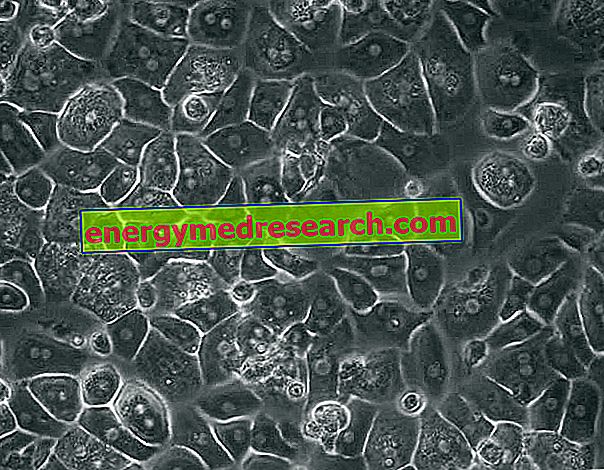Generality
Mediterranean anemia (or beta-thalassemia ) is an inherited blood disorder .
The patients who are affected have a lower amount of red blood cells than the norm, with defects in the synthesis of hemoglobin (Hb, the protein responsible for transporting oxygen).

The extent of the disorder, the symptoms and the consequences are very variable and depend fundamentally on the type of genetic defect. In fact, there are 3 different forms of Mediterranean anemia:
- Thalassemia major (or Cooley's disease);
- Thalassemia intermediate ;
- Thalassemia minor .
In the most serious cases, Mediterranean anemia is crippling and puts people's lives at risk; in other forms, it is almost asymptomatic. There is also the possibility of being a healthy carrier, with the risk of generating children who will develop the disease.
Mediterranean anemia is detectable by genetic tests and blood tests; the latter will show the presence of red blood cells of irregular, fragile, scarce dimensions and smaller than the norm.
Treatment involves several approaches, including more or less recurrent blood transfusions associated with chelation therapy (to prevent iron accumulation) and bone marrow transplantation from compatible donors. Sometimes, no therapeutic intervention is necessary.
Did you know that ...
Mediterranean anemia owes its name to the fact that it was initially observed among the Mediterranean populations. In Europe, the disease is concentrated mainly in Greece, the Turkish coasts and in the islands, including Sicily and Sardinia.
On our national territory, the area of the Po delta and the Ciociaria are among the most affected places. It is estimated that in Italy there are about 2.5 million people suffering from Mediterranean anemia, even though for the most part they are healthy carriers.
The disease is also widespread in Central and South-Eastern Asia, in India and in China.
What's this
Mediterranean anemia is a form of thalassemia caused by reduced or absent synthesis of beta-globin hemoglobin chains .
The consequences of this dysfunction are:
- Clinical picture of microcytic and hypochromic anemia;
- Early destruction of red blood cells (hemolysis), with different relapses throughout the body;
- Ineffective erythropoiesis of variable severity (the bone marrow produces small, fragile red blood cells which are above all poor in oxygen to be transported to the tissues).
The role of hemoglobin
Hemoglobin (Hb) is a protein contained within red blood cells, specializing in the transport of oxygen to various parts of the body. In a healthy adult, his concentration should not fall below 12 g / dl. The reduction of hemoglobin, associated with that of red blood cells in the bloodstream, involves symptoms that characterize Mediterranean anemia.
Causes
Mediterranean anemia is a haematological disease of genetic origin .
The clinical picture is due to very heterogeneous alterations (point mutations, deletions, etc.) in the HBB gene (11p15.5), which codes for the beta-globins essential in hemoglobin synthesis. It must be remembered, in fact, that this molecule is composed of four subunits: two alpha chains and two beta chains.
At the base of Mediterranean anemia there is a genetic aberration that involves the scarce (β +) or absent (β0) production of beta chains: the resulting hemoglobin is scarce and damages the membrane of red blood cells, which are destroyed .
Classification
There are 3 different forms of Mediterranean anemia, classified according to the severity of the disorder:
- Thalassemia major (or Cooley's disease) : it generally appears within 2 years of age and, to survive, requires periodic blood transfusions throughout the course of life, in addition to the use of specific drugs.
- Intermediate thalassemia : less severe form; it can remain latent or manifest itself in a similar way to the major, and need occasional transfusions to improve the quality of life.
- Thalassemia minor : generally asymptomatic, does not require special treatments, but regular checks of blood values.
Main genetic mechanisms responsible for the forms of Mediterranean anemia | |
Type of mutation | Phenotype |
"Non-sense" point mutations | β0-thalassemia |
Mutations of exons / introns or sites near these sequences, with alterations of the normal mRNA formation process | β + and β0-thalassemia |
Mutations of promoter sequences | β + thalassemia |
Deletions of globin (rare) genes | β0-thalassemia |
How it is transmitted
Transmission is autosomal recessive, so only a child whose parents are both carriers may be affected by Mediterranean anemia.
Healthy carrier of Mediterranean anemia: what risks?
Healthy carriers of Mediterranean anemia are people who present the genetic defect underlying the disease, but are asymptomatic and lead a normal life.
However, this condition carries risks. If the partner is a healthy (or ill) carrier, children with Mediterranean anemia could be born: there is a 25% chance that the child will develop a serious form, another 25% that is not sick and a remaining 50% who manifest a slight picture.
Symptoms and complications
Mediterranean anemia presents very variable clinical pictures, which depend on the severity of the genetic aberration at the base.
The mild forms of this haematological disorder can be almost asymptomatic.
The symptoms are severe especially in the Mediterranean major anemia and may include:
- Progressive pallor;
- Fatigue;
- Muscle weakness;
- Slow development and jaundice in the child;
- Bone changes (thickening of the skull, protruding cheekbones, valgus knee and pathological fractures of long bones);
- Anorexia (lack of appetite);
- Cancellation of the general conditions;
- Recurrent fever attacks;
- Diarrhea;
- Irritability;
- Progressive distension of the abdomen (secondary to splenomegaly and hepatomegaly).
In the case of regular transfusions, growth and development in children with Mediterranean anemia tend to be normal. Over time, however, there may be complications from iron overload, such as delayed bodily development and sexual maturation, hemochromatosis and hepatic siderosis.
Mediterranean anemia predisposes to the development of various pathologies.
First of all, to compensate for the lack of red blood cells, the bone marrow will strive to produce more. This reaction results in the tendency to form longer and more fragile bones, with the risk of developing osteoporosis. Similar mechanism concerns the spleen, which will face the same effort. The consequences are an enlargement of the organ which, furthermore, is distracted by other functions, such as contributing to the defense of the organism against infections.
Frequent blood transfusions, caused by the treatment of severe Mediterranean anemia, create an accumulation of iron, with the risk of toxicosis that can damage organs, such as the liver and the heart.
Among the consequences of Mediterranean anemia, we can also observe:
- Endocrine disorders and hormonal imbalances (including hypothyroidism, parathyroid and adrenal insufficiency and diabetes mellitus);
- Cholelithiasis (as in sickle cell anemia);
- Skin ulcers in the lower limbs due to chronic venous insufficiency.
On the other hand, people suffering from Mediterranean anemia are more protected against malaria : as the red blood cells are small and scarce, the plasmodium fails to take advantage of the blood system that it would like to parasitize.
Diagnosis
If it is diagnosed in time, Mediterranean anemia does not prevent us from leading an almost normal life.
The suspicion of Mediterranean anemia may arise with a visit after birth, due to the appearance of a suggestive symptomatology (such as jaundice and poor growth).
In addition to the symptoms, the diagnosis is based on the execution of some blood tests to determine:
- Quantity and type of hemoglobin;
- Number and volume of red blood cells.
The diagnosis is confirmed, then, by genetic tests. In addition, haemolytic signs associated with ineffective erythropoiesis, with indirect hyperbilirubinemia, hypersideremia and hyperferritinemia are found.
Prenatal diagnosis
During pregnancy, it is possible to verify whether the child will be born with Mediterranean anemia, through prenatal diagnosis on chorionic villi or amniocentesis. Prenatal screening is important especially in the areas of greatest diffusion.
For future parents who want to know if they are healthy carriers of Mediterranean anemia, it is possible to undergo the study of hemoglobin, for which a simple blood test is necessary.
Therapy
The treatment involves different approaches, including:
- Blood transfusions to make up for the lack of red blood cells, possibly associated with a chelation therapy to avoid iron accumulation;
- Splenectomy (if the disease causes severe anemia or splenomegaly);
- Bone marrow or stem cell transplant from compatible donors.
Generally, major Mediterranean anemia involves treatment with regular blood transfusions (on average one every 15 days in severe cases), while in intermediate thalassemia a few cycles are sufficient when hemoglobin is too low.
However, transfusions cause an accumulation of iron in the body, which can cause problems especially in the heart and liver. To avoid these damages, it is necessary to establish a continuous therapy with iron chelating drugs, that is capable of trapping and eliminating excess iron from the body.
In some cases, bone marrow transplantation can be used, the only "definitive" therapy for Mediterranean anemia. However, the chances of finding a compatible donor are limited (about 25%), without considering the contraindications and the risks of this type of intervention, including the rejection by the organism. For these reasons, this procedure is usually reserved for rare cases, in the presence of people suffering from a very severe form of Mediterranean anemia and with available HLA-identical family donors (brothers or sisters of the patient).
In addition to specific therapies, great importance is given to regularly practiced physical activity and nutrition.
In particular, it can be useful:
- Limit foods of animal origin and rich in iron, such as liver, pork, beef, offal and mussels;
- Accompany meals with tea in order to reduce iron absorption;
- Consume foods rich in calcium and vitamin D, due to the risk of osteoporosis;
- Take folic acid supplements (to increase red blood cell production).
In any case, the doctor will be able to advise the thalassemia patient on the best interventions to manage their condition.
Prognosis
The right attention to physical activity and nutrition, together with the most suitable therapy, can significantly improve the quality of life of people who suffer from Mediterranean anemia.



